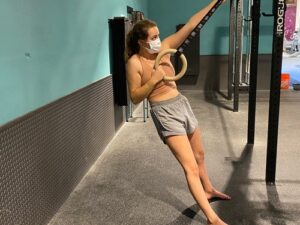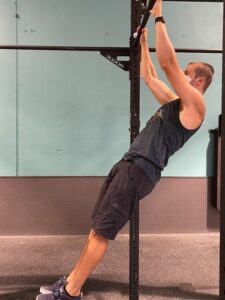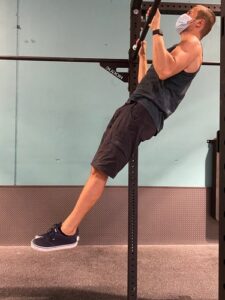The pull-up. A major staples of most training plans in the history of training plans. It is a magnificent little exercise that uses muscles that you neglect in most other forms of training. Unfortunately, the pull-up is not an ideal exercise for developing climbing specific pulling skills. And since we are here to talk climbing, its worth discussing the why and alternatives.
The reason for this lackluster carry over into climbing is that it all takes place in the wrong direction. Most of the time when climbing you are not pulling straight up and down with your body parallel to the wall. Even on vertical terrain, your upper body is leaning away from the wall at an angle, so you pull into the wall, and push down on holds, as you push with your feet. On an overhanging wall this is even more pronounced, as your center of gravity drops away from the wall and your hands move in front of you. Hence, having your arms above your head and pulling up and down isn’t closely mimicking what you are doing when you climb. I am sure many of your have heard stories of freakishly strong climbers like Dave Graham or Adam Ondra not being able to pull very hard in isolation, but able to climb at world-class levels. Fingers, core, and a strong determination helped them much more than endless pull-ups.
All this being said, I have seen many clients, especially women and some of the younger kids I worked with, get great climbing results when they reach a certain number of pull-ups. This number is lower than you may think though. Somewhere in the ballpark of 10 pull-ups, return on investment starts to drop.
So, how do balance the training demands of pulling, which is paramount during difficult movement, while at the same time not wasting time with movement that doesn’t translate? Don’t get me wrong here, I strongly believe that many of us will still benefit from some pulling exercises and in teaching our bodies how to engage these pull muscles to accomplish our climbing goals. The goal is how to do so effectively without wasted effort.
Here are some alternative exercises that are more beneficial in helping develop these strengths. Some of them can even be done before you are able to execute strict pull-ups, giving you an opportunity to start working on your pulling sooner than you thought.
Inverted Rows (Double or Single Arm)
Inverted rows have the potential to get you doing more pulling even if you are below the threshold of 10 pull-ups we talked about earlier. This exercise is great in that it can be done with both arms or progressed to single arm, to increase difficulty. The position of your body can help modulate difficulty as well. It can be done with a suspension trainer or off of a bar, easily accommodating what ever equipment limitation you may have.
Double Arm:


Single Arm:


To make this exercise easier walk your feet towards your body. Walk them away to get more core engaged and more weight into your hands. Play around with the base and see what it feels like. This has many possibilities for modification. Start with something that allows you to get around 8 to 10 repetitions in and build from there.
Quarter Lever Pull-Up
This exercise has the benefit of position your body in a climbing specific position while still keeping all the benefits of regular pull-ups. Try to keep your body positioned in the same angle as you pull through each rep. This can be made harder by choosing smaller grips on your board, if using a hangboard. Alternatively, if on a pull-up bar, you can widen your grip, or stagger it by throwing something over the bar to extend the grip downward for one hand. If you are already well versed in pulling, see if you can start with 6 to 8 reps with good form (don’t let you body sag or lose tension). Keeping engagement throughout longer rep ranges is difficult, since your body is under tension for a long time. A great way to build endurance for full body engagement.


Cannon Ball Pull-Up
This an also be done on a pull-up bar or hangboard. Position your body in the cannonball shape by tucking your legs into your chest and learning back until you are parallel to the floor. From there, pull. Simple but challenging. This is a tough exercise that requires comfort with being inverted, engaging your core, and pulling in a different direction than traditionally found in pull-ups. Make sure you have a strong base in pulling before attempting and use a spotter when starting out to watch your back. Aim for comfort before you go for reps. Keep in mind that your chest is going to activate a lot more during this movement as compared to regular pull-ups. Once these start to feel easy, try extending one leg out and executing the same pull movement; this takes it to a whole new level.


Good training is all about finding exercises that are effective. The world of training can be hard to navigate and full of wasted effort. Find out what you need to work on and dive in. These pulling exercises are great to help get your body feeling more competent at engaging your upper body during climbing movement. This is a must for completing challenging moves. Progress can be made relatively quickly and if you stick with these for a few weeks, you notice your body responding better on the wall.
Have you found any exercises that work for you in improving your pulling strength? Please leave a comment below and share so others can get ideas. Good luck and train on.
